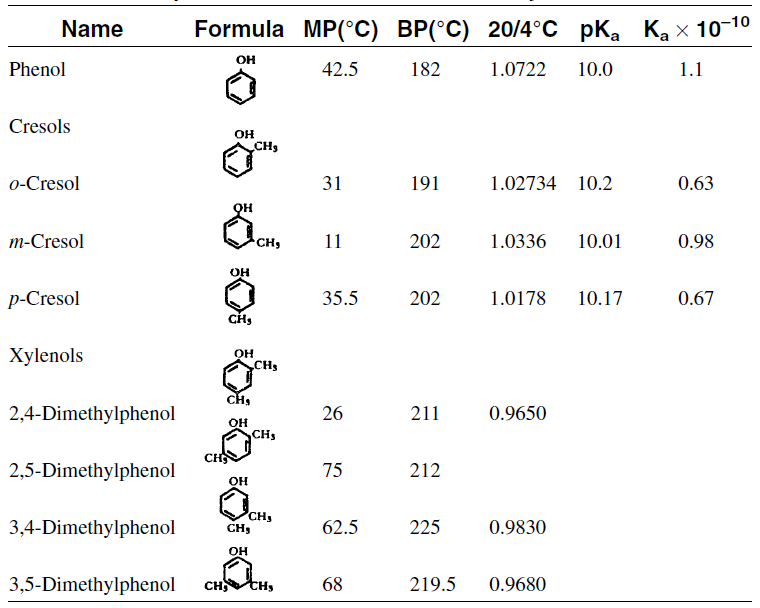


 علم الكيمياء
علم الكيمياء 
 الكيمياء التحليلية
الكيمياء التحليلية 
 الكيمياء الحياتية
الكيمياء الحياتية 
 الكيمياء العضوية
الكيمياء العضوية 
 الكيمياء الفيزيائية
الكيمياء الفيزيائية
 الكيمياء اللاعضوية
الكيمياء اللاعضوية 
 مواضيع اخرى في الكيمياء
مواضيع اخرى في الكيمياء
 الكيمياء الصناعية
الكيمياء الصناعية |
Read More
Date: 9-5-2016
Date: 6-9-2017
Date: 31-8-2017
|
CRESYLIC ACID
Cresylic acid is a commercial mixture of phenolic compounds including phenol, cresols, and xylenols. This mixture varies widely according to its source. Properties of phenol, cresols, and xylenols are shown in Table 1.1 Cresylic acid constitutes part of the oxygen compounds found in crudes that are concentrated in the naphtha fraction obtained principally from naphthenic and asphaltic-based crudes. Phenolic compounds, which are weak acids, are extracted with relatively strong aqueous caustic solutions.
Originally cresylic acid was obtained from caustic waste streams that resulted from treating light distillates with caustic solutions to reduce H2S and mercaptans. Currently, most of these streams are hydrodesulfurized, and the product streams practically do not contain phenolic compounds.
However, cresylic acid is still obtained to a lesser extent from petroleum fractions, especially cracked gasolines, which contain higher percentages of phenols. It is also extracted from coal liquids.
Strong alkaline solutions are used to extract cresylic acid. The aqueous layer contains, in addition to sodium phenate and cresylate, a small amount of sodium naphthenates and sodium mercaptides. The reaction between cresols and sodium hydroxide gives sodium cresylate.
Table 1.1: Properties of Phenol, Cresols and Xylenols

Mercaptans in the aqueous extract are oxidized to the disulfides, which are insoluble in water and can be separated from the cresylate solution by decantation:

Free cresylic acid is obtained by treating the solution with a weak acid or dilute sulfuric acid. Refinery flue gases containing CO2 are sometimes used to release cresylic acid. Aqueous streams with low cresylic acid concentrations are separated by adsorption by passing them through one or more beds containing a high adsorbent resin. The resin is regenerated with 1% sodium hydroxide solution.
It should be noted that the extraction of cresylic acid does not create an isolation problem with naphthenic acids which are principally present in heavier fractions. Naphthenic acids, which are relatively stronger acids (lower pKa value), are extracted with less concentrated caustic solution.



|
|
|
|
مخاطر خفية لمكون شائع في مشروبات الطاقة والمكملات الغذائية
|
|
|
|
|
|
|
"آبل" تشغّل نظامها الجديد للذكاء الاصطناعي على أجهزتها
|
|
|
|
|
|
|
تستخدم لأول مرة... مستشفى الإمام زين العابدين (ع) التابع للعتبة الحسينية يعتمد تقنيات حديثة في تثبيت الكسور المعقدة
|
|
|